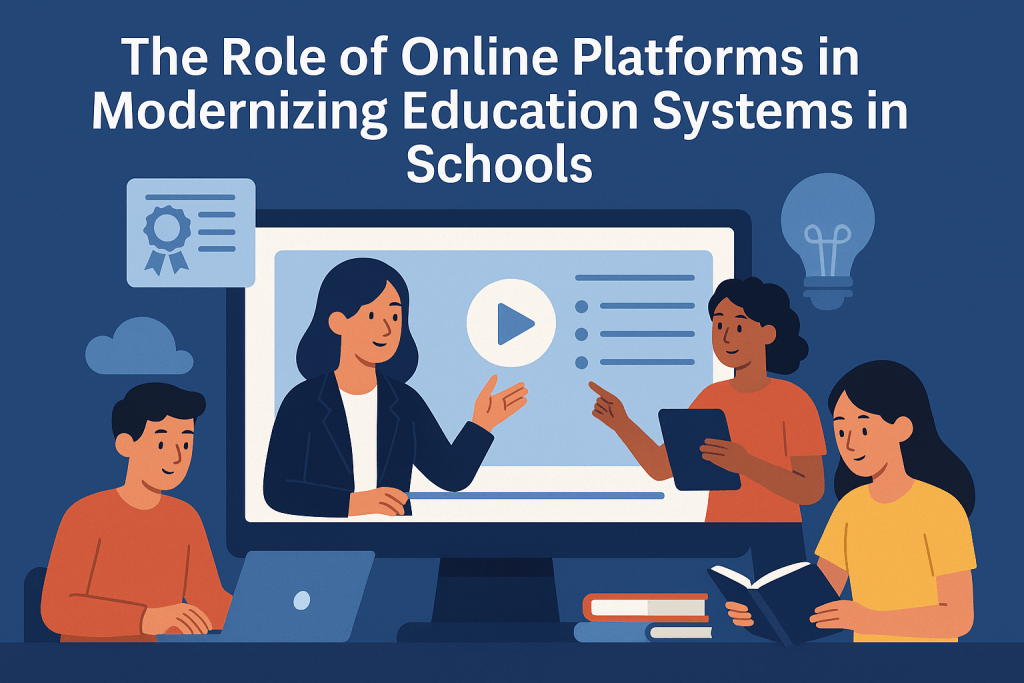The educational landscape has undergone a remarkable transformation in recent years, with technology reshaping how students learn and how teachers deliver instruction. According to a survey, 36% of parents are somewhat or very worried about their child falling behind in school during the pandemic. This concern has accelerated the adoption of digital solutions in classrooms across the country.
Schools are now embracing online education platforms that promise to address longstanding challenges while preparing students for an increasingly digital future. From personalized learning experiences to global classroom connections, these technologies are redefining what’s possible in modern education.

Transforming Traditional Classrooms Through Digital Innovation
The shift from traditional teaching methods to technology-enhanced education represents one of the most significant changes in how we approach learning. Digital tools are creating new possibilities for both teachers and students.
Today’s classroom looks dramatically different from the one many of us remember. Interactive whiteboards have replaced chalkboards, tablets have replaced textbooks, and online learning in schools has become commonplace. This digital revolution isn’t just about new gadgets, it’s about fundamentally changing how students engage with content and develop skills.
Many schools struggle with limited resources, student engagement issues, and the need to prepare young people for jobs that don’t even exist yet. Education technology helps address these challenges by making quality resources more accessible to all students.
Digital tools aren’t just changing what students learn, they’re transforming how they learn. Digital learning tools help students visualize complex concepts, collaborate with peers remotely, and receive instant feedback on their work. Teachers can track progress more efficiently and intervene earlier when students struggle.
One standout advancement is the rise of virtual tutoring programs, which offer students on-demand academic support beyond traditional classroom hours. These programs bridge learning gaps, reinforce key concepts, and ensure that students receive the help they need, regardless of their location or schedule, contributing to a more modern, inclusive education system.
The Evolution of Education Technology
Education technology has come a long way from the early days of computer labs and educational software. Today’s digital resources are more sophisticated, accessible, and integrated into every aspect of the learning experience.
Technology in schools isn’t entirely new. From filmstrip projectors to early computer labs, educators have long sought to enhance learning through technology. However, early technology was often siloed, separate from regular classroom activities and used only occasionally as a supplement.
The development of the Internet fundamentally changed how technology could be used in schools. As connectivity improved, learning management systems emerged, allowing teachers to organize content and track student progress online. The introduction of tablets and affordable laptops then brought computing power directly to student desks.
From Supplementary Tools to Digital Ecosystems
Today’s digital learning tools are no longer add-ons to traditional education, they’re integral components of comprehensive learning ecosystems. Schools are implementing platforms that connect all aspects of education, from attendance and gradebooks to instruction and assessment.
The rapid evolution of educational technology has laid the foundation for today’s comprehensive digital learning environments. These advancements have yielded significant benefits that are transforming modern education systems.
Core Benefits of Online Education Platforms in Modern Schools
Online education platforms offer multiple advantages that elevate the educational experience for all stakeholders. These benefits address many of the challenges facing modern education systems.
Enhanced Accessibility and Inclusivity
One of the most powerful aspects of modernizing education is how it democratizes learning opportunities. Digital platforms make quality education more accessible to diverse learners.
Breaking Geographical Barriers
Students no longer need to be physically present in elite institutions to access outstanding educational resources. Online platforms deliver expert instruction to remote and rural areas where specialized teachers might be scarce.
Accommodating Diverse Learning Needs
Digital tools offer flexibility for students with different learning styles and abilities. Text-to-speech features, closed captioning, and adjustable reading levels help make content accessible to all learners, including those with disabilities.
Expanding Educational Opportunities
Education technology helps level the playing field by providing resources to underserved communities. Students from all backgrounds can access advanced courses, specialized instruction, and enrichment activities that might otherwise be unavailable to them.
Personalized Learning Experiences
Perhaps the most revolutionary aspect of modern educational technology is its ability to customize learning for each student’s needs.
AI-Driven Adaptive Learning
Sophisticated algorithms track student performance and automatically adjust content difficulty, pace, and presentation. This creates learning experiences tailored to each student’s strengths, weaknesses, and learning style.
Custom Learning Pathways
Digital platforms allow students to follow their interests while still meeting curriculum requirements. Teachers can assign personalized learning sequences based on individual assessment data rather than teaching to the middle.
Self-Paced Learning Opportunities
Students can progress through the material at their own pace, spending more time on challenging concepts and moving quickly through material they grasp easily. This reduces frustration for both struggling and advanced learners.
The personalization capabilities of modern educational platforms represent a fundamental shift from one-size-fits-all instruction to truly student-centered learning. These individualized approaches help boost engagement through immersive, interactive experiences.
Embracing the Digital Future of Education
The integration of online education platforms into school systems represents more than just technological adoption, it’s a fundamental reimagining of how education can work.
While challenges remain in ensuring equitable access and balancing screen time with other important learning experiences, the transformative potential of educational technology is undeniable. Schools that thoughtfully implement digital learning tools while maintaining focus on human connection and holistic student development will be best positioned to prepare young people for tomorrow’s opportunities.
As we look toward the future of education, one thing seems certain: the thoughtful integration of technology will continue to play a vital role in creating learning experiences that are more personalized, engaging, and effective than ever before.
Common Questions About Education Technology
How is technology changing the role of teachers in modern classrooms?
Technology isn’t replacing teachers but transforming their role from information providers to learning facilitators. With content delivery handled by digital tools, teachers spend more time mentoring students, guiding discussions, and providing targeted support where it’s needed most.
What are the most cost-effective ways to implement digital learning tools in schools with limited budgets?
Schools with budget constraints can start with free or low-cost options like open educational resources, implementing BYOD (bring your own device) policies, and using tiered implementation strategies that prioritize the most impactful tools first.
How can schools ensure equitable access to technology for all students?
Equity requires multi-faceted approaches, including device lending programs, community partnerships for home internet access, extended building hours for technology use, and ensuring all digital resources work across multiple platforms and device types.
